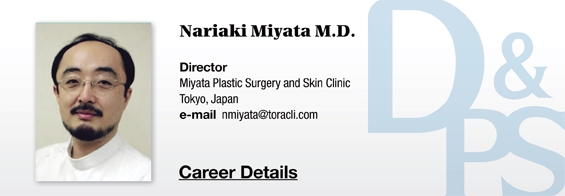
The amount of HA used per patient in Japan is very low. In most cases, only one 1cc vial is used in a local treatment and few doctors use 3-4 vials in one treatment. In my personal opinion, Japanese doctors tend to prefer shallow injections and this allows them to use only a small amount of the filler. I believe it is about time that new injection techniques for overall facial contouring and volume change should be considered in Japan.
MERZ’s Radiesse, a CaHA type filler, is also widely used although not to the extent of HA. This product is not yet approved. This product is my personal favorite although its market share may decline in the future. The CaHA filler has superior viscosity and elasticity compared to HA fillers and allows easier shaping after injection. Therefore, CaHA fillers are the first choice when it comes to nose or chin areas. Injecting immediately above the bone can bring natural volumizing effects in the cheek and temple areas. The biggest disadvantage of this product is that it cannot be reversed in case of a complication. Saline solution can be injected to reduce volume but CaHA fillers cannot be dissolved.
CaHA fillers require particular caution when injecting into the lower eyelid. This poses a big challenge for novice doctors and they tend to choose other filler types. However, an experienced doctor can combine CaHA with HA for superior outcome. I hope CaHA fillers become more widely used in Japan.
[Advertisement] MAGNUM(Q-switched Nd:YAG Laser) – Manufacturer: (www.i-dana.com)]
I have given a lecture on Radiesse injection techniques to an audience of Japanese doctors at an academic seminar. Many doctors failed to understand special characteristics of the product and found it difficult to use. Other products such as Sculptra and NewFill were also introduced in Japan but they are rarely used in clinical practice.
Another aspect of importance when it comes to dermal filler procedures is the injection devices. Cannulas have become popular in the recent years but some doctors still prefer needles for better precision. Controversy still remains in the international academia over which device is better. Cannulas provide better safety, however, needles are preferred for accuracy.
It is most important to prevent the risk of embolism when performing dermal filler injections. The rate of post-injection embolism in Japan is very low compared to Korea or Taiwan, probably due to the generally cautious attitude of the Japanese doctors. This may also be due to the low proportion of injections among overall aesthetic treatments.
Embolism cannot be completely avoided even by the most seasoned doctors. I have also dealt with a high risk of embolism. It goes without saying that one should be well-versed in vascular anatomy. Following Juvederm’s approval, Allergan is promoting their product in doctors inexperienced in aesthetic treatment by only providing basic training. I think this poses a problem. More novice doctors venturing into new products can lead to higher number of complications or side effects, which can be a big headache for all of us. Using a cannula can reduce the risk of compressing a blood vessel, but that does not mean the risk disappears. I would like to emphasize again that sufficient knowledge and experience is needed for safe dermal filler procedures.
-To be continued-




















